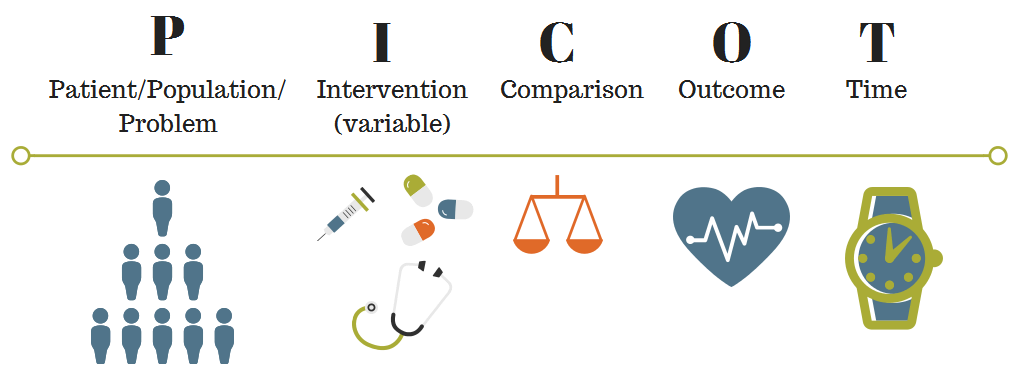This weeks assignment is STEP 2 – Project Purpose Statement, Background & Significance and PICOt Formatted Clinical Project Question
This weeks assignment is STEP 2 – Project Purpose Statement, Background & Significance and PICOt Formatted Clinical Project Question

This weeks assignment is STEP 2 – Project Purpose Statement, Background & Significance and PICOt Formatted Clinical Project Question.
The student will answer the items below in a Word doc and submit to the assignment link.
- Provide a title that conveys or describes the assignment.
- Project Purpose Statement – Provide a declarative sentence or two which summarizes the specific topic and goals of the project.
- Background and Significance – State the importance of the problem and emphasize what is innovative about your proposed project. Discuss the potential impact of your project on your anticipated results to the betterment of health and/or health outcomes.
- PICOt formatted Clinical Project Questions – Provide the Population, Intervention, Comparison, Expected Outcomes and timeframe for the proposed project.
- References – Cite references using APA 7th ed format.
Expectations
- Due: Monday, 11:59 pm PT
- Length: See section requirements above
- Format: Completed template with references in APA 7th ed. format
- File name: Save the file with Student First Name_Last Name_Part 2
See USU NUR Writing Assignment Rubric for additional details and point weighting.
Increasing Vaccination Rate Among Adults Through Awareness Campaigns – Sample Answer
Prevention is better than cure. Vaccination is crucial in children and adults because it helps prevent infections, diseases, and disabilities. However, when it comes to vaccination and immunization among adults, vaccination is overlooked. Lack of information about the vaccines available for adults is a significant factor contributing to vaccine-preventable diseases. Failing to take vaccines contributes to a high incidence of preventable illnesses that contributes to high mortality rates, especially in patients with a weakened immune system.
According to World Health Organization, about 50,000 adults die annually from vaccine-preventable diseases (Lu et al., 2017). The purpose of this paper is to evaluate practical ways of creating vaccination awareness among adults.
Background and Significance
Vaccines are free and readily available in hospitals. If the adults embraced them for preventable diseases such as tetanus, influenza, polio, mumps, whooping cough, Hepatitis A and B, rubella, measles, diphtheria, and pneumococcal infections mortality rate could be reduced. The predisposing factors of these illnesses in adulthood are age, occupation, lifestyle, and health. Taking vaccines is a safe way of protecting one’s health and reducing health complications (Zheng et al., 2018).
It also helps to prevent the spread of diseases from one person to another. Most adults are skeptical about vaccines and are hesitant to use them. Also, they lack a safe place where they can raise their concerns about vaccines. Having educative sessions for the public about vaccination can help change the attitude towards vaccines and increase responsiveness. As a result, many preventable diseases will no longer be a concern in society.
Providing accurate information about vaccines can improve people’s resilience towards vaccination. Addressing the public’s attitude towards vaccines can help to bring down all the myths about vaccines. If health care workers reinforce that immunization is one of the most acceptable health behavior, people will uphold it as a social norm. Social media is an effective tool because health workers can connect globally and conduct campaigns to stir adults to participate in vaccination (Navin et al., 2019). After creating awareness about vaccines, health practitioners should ensure that vaccines are available to all people without any barriers. Stock-outs should be replenished immediately to ensure no one is left out in the process.
Knowledge is power. Equipping people with knowledge about vaccines is one of the strides towards defeating some diseases. Also, addressing the mythical beliefs about vaccines can help to change the attitude toward vaccination. As a result, people will be aware of the vaccines available and their importance. Creating vaccine awareness among adults will increase the turnout of adults to take part in vaccinations (Ahmed et al., 2018). The aftermath will be a reduced number of vaccine-preventable diseases and a decline in deaths. There will also be a reduced economic burden as the number of illnesses reported in hospitals will decrease.
PICOt Analysis
Population/Patient
Although vaccines are available for both children and adults, many adults do participate in vaccination. As a result, many vaccine-preventable diseases occur in adults than children (Talbird et al., 2021). Most of the adults with vaccine-preventable illnesses are hospitalized due to health complications, and some eventually die. Taking vaccines helps to prevent such diseases from occurring. However, most adults are not well informed about the vaccines.
Interventions
Vaccine-preventable diseases are a global concern, and their impact is grave if no control measures are implemented. In this era, social media has made it possible to pass information across borders and instantly. If health workers joined together to hold campaigns about vaccination, this could bring more awareness among the adults. Also, it can provide an excellent avenue to address questions from the public about vaccination. Doing this will make adults more informed about the health choices they make.
Comparison
Vaccines are a significant breakthrough in the health sector. They help to prevent diseases by boosting the body’s defense system. However, the levels of vaccine-preventable diseases remain high and claim lives. Taking preventative measures against diseases would be an easier way than curing them. This logic shows that there is an information gap among adults concerning vaccines. If they were well informed and took the initiative to be vaccinated, there could b fewer cases of vaccine-preventable diseases.
Outcome
Carrying out vaccination campaigns by health workers portrays vaccination as an urgent and crucial activity, which is. People will be charged to take responsibility for their health and will, as a result, seek vaccination. This intervention will promote healthy choices, and the prevalence and deaths resulting from vaccine-preventable diseases will reduce.
Timeframe
A period of six months would be effective for the project. This time will be enough to carry out vaccination campaigns, set up vaccination centers, and collect data on the number of adults who respond to the vaccination call.
PICOt Question
For adults, does the use of vaccination awareness campaigns through social media increase the vaccination rate?
Conclusion
Vaccines are essential because they help to prevent diseases. However, many adults die from vaccine-preventable illnesses because they fail to take part in vaccination. Offering information about vaccines is a critical way that can increase the rate of vaccination among adults. Social media provides a good platform for health workers to reach out to people and educate them about vaccines. This intervention is crucial and can reduce the prevalence and the mortality of preventable diseases through vaccination.
References
Ahmed, N., Quinn, S. C., Hancock, G. R., Freimuth, V. S., & Jamison, A. (2018). Social media use and influenza vaccine uptake among White and African American adults. Vaccine, 36(49), 7556-7561. https://doi.org/10.1016/j.vaccine.2018.10.049
Lu, P. J., O’Halloran, A., Kennedy, E. D., Williams, W. W., Kim, D., Fiebelkorn, A. P., … & Bridges, C. B. (2017). Awareness among adults of vaccine-preventable diseases and recommended vaccinations, United States, 2015. Vaccine, 35(23), 3104-3115. https://doi.org/10.1016/j.vaccine.2017.04.028
Navin, M. C., Wasserman, J. A., Ahmad, M., & Bies, S. (2019). Vaccine education, reasons for refusal, and vaccination behavior. American journal of preventive medicine, 56(3), 359-367. https://doi.org/10.1016/j.amepre.2018.10.024
Talbird, S. E., La, E. M., Carrico, J., Poston, S., Poirrier, J. E., DeMartino, J. K., & Hogea, C. S. (2021). Impact of population aging on the burden of vaccine-preventable diseases among older adults in the United States. Human vaccines & immunotherapeutics, 17(2), 332-343. https://doi.org/10.1080/21645515.2020.1780847
Zheng, Z., Diaz-Arévalo, D., Guan, H., & Zeng, M. (2018). Noninvasive vaccination against infectious diseases. Human vaccines & immunotherapeutics, 14(7), 1717-1733. https://doi.org/10.1080/21645515.2018.1461296
Do You Want Original Paper Written From Scratch For Similar Assignment? Click Here To Place Your Order Use Coupon Code: NEW30 to Get 30% OFF Your First Order
Use Coupon Code: NEW30 to Get 30% OFF Your First Order
Complete Guide to STEP 2 Nursing Project: Purpose Statement, Background & Significance and PICOT Formatted Clinical Project Question

Introduction
Nursing students pursuing advanced degrees often encounter the critical STEP 2 Project Purpose Statement, Background & Significance and PICOT Formatted Clinical Project Question assignment. This comprehensive guide provides evidence-based strategies to excel in this crucial academic milestone.
The evidence-based practice (EBP) competencies of cultivating inquiry and formulation of Population, Intervention, Outcome, and Time (PICOT) questions are essential to quality improvement, healthcare outcomes, and the development of Doctor of Nursing Practice (DNP) scholarly projects.
Understanding the Three Core Components
1. Project Purpose Statement
A project purpose statement serves as the foundation of your nursing research project. State concisely and realistically the expected clinical impact of this project, i.e., what the clinical project is intended to accomplish and/or demonstrate.
Key Elements of an Effective Purpose Statement:
- Declarative nature: Clear, direct statement
- Specific focus: Narrow, well-defined scope
- Measurable outcomes: Quantifiable results
- Clinical relevance: Direct healthcare application
- Minimum 40 words: Meets academic requirements
Purpose Statement Template:
The purpose of this [project type] is to [action verb] [specific intervention/strategy]
among [target population] in [setting] to [expected outcome] over [timeframe].2. Background & Significance
The background and significance section establishes the contextual foundation and importance of your research project.
Background Components:
- Literature synthesis: Current state of knowledge
- Problem identification: Gap in practice or knowledge
- Theoretical framework: Conceptual foundation
- Clinical context: Real-world application
Significance Elements:
- Healthcare impact: Patient outcomes improvement
- Professional implications: Nursing practice advancement
- Economic considerations: Cost-effectiveness
- Quality indicators: Measurable improvements
3. PICOT Formatted Clinical Project Question
The PICOT (Population, Intervention, Comparison, Out – come, Timeframe) framework succinctly gives structure to developing and solving a research or clinical question.
The PICOT Framework Explained
The PICOT question format is a consistent “formula” for developing answerable, researchable questions.
PICOT Components Breakdown:
| Component | Definition | Example |
|---|---|---|
| P – Population | Target group or patient demographic | Adult patients with Type 2 diabetes |
| I – Intervention | Treatment or action being studied | Structured diabetes education program |
| C – Comparison | Alternative treatment or control | Standard care without structured education |
| O – Outcome | Desired result or measurement | Improved medication adherence rates |
| T – Time | Duration of study or follow-up | 6-month follow-up period |
PICOT Question Types:
- Intervention Questions: Focus on treatment effectiveness
- Prognosis Questions: Predict outcomes over time
- Diagnosis Questions: Evaluate diagnostic tools
- Etiology Questions: Explore cause-and-effect relationships
- Meaning Questions: Understand patient experiences
Step-by-Step Development Process
Phase 1: Preparation and Research
- Literature Review
- Conduct systematic search of current evidence
- Identify gaps in existing knowledge
- Analyze similar studies and interventions
- Problem Identification
- Define the clinical problem clearly
- Quantify the problem’s scope and impact
- Establish urgency and relevance
Phase 2: Purpose Statement Development
Writing Strategy:
- Start with the action: Use strong action verbs (examine, evaluate, implement, assess)
- Define the population: Be specific about demographics and characteristics
- Specify the intervention: Clearly describe what will be done
- Identify the setting: Where will the project take place
- State expected outcomes: What changes are anticipated
Common Mistakes to Avoid:
- Vague or overly broad statements
- Lack of measurable outcomes
- Insufficient word count
- Missing clinical relevance
Phase 3: Background and Significance Construction
Background Development:
- Current State Analysis
- Review existing literature
- Identify best practices
- Highlight knowledge gaps
- Theoretical Framework Selection
- Choose appropriate nursing theory
- Align with project goals
- Provide conceptual foundation
Significance Justification:
- Clinical Impact
- Patient safety improvements
- Quality of care enhancements
- Cost-effectiveness analysis
- Professional Relevance
- Nursing practice advancement
- Evidence-based care promotion
- Professional development
Phase 4: PICOT Question Formulation
Question Development Process:
- Identify the clinical question
- Break down into PICOT components
- Ensure each element is specific and measurable
- Format according to question type
- Validate with literature support
Practical Examples and Templates
Example 1: Intervention PICOT Question
Clinical Scenario: Reducing hospital-acquired infections in ICU patients
PICOT Breakdown:
- P: Adult ICU patients
- I: Enhanced hand hygiene protocol
- C: Standard hand hygiene practices
- O: Reduced hospital-acquired infection rates
- T: 3-month implementation period
Formatted Question: “In adult ICU patients (P), does implementing an enhanced hand hygiene protocol (I) compared to standard hand hygiene practices (C) reduce hospital-acquired infection rates (O) over a 3-month period (T)?”
Example 2: Prognosis PICOT Question
Clinical Scenario: Predicting readmission rates in heart failure patients
PICOT Breakdown:
- P: Heart failure patients post-discharge
- I: Risk assessment tool
- C: Not applicable (prognosis question)
- O: 30-day readmission rates
- T: 30 days post-discharge
Formatted Question: “In heart failure patients post-discharge (P), does using a validated risk assessment tool (I) accurately predict 30-day readmission rates (O) within 30 days of discharge (T)?”
Quality Assurance and Validation
Evaluation Criteria:
| Criteria | Purpose Statement | Background & Significance | PICOT Question |
|---|---|---|---|
| Clarity | Clear, concise language | Logical flow and organization | Specific, answerable format |
| Specificity | Defined scope and goals | Focused literature review | Measurable components |
| Relevance | Clinical significance | Current evidence base | Practical application |
| Feasibility | Realistic expectations | Available resources | Achievable timeline |
Common Assessment Rubric Elements:
- Content Quality (40%)
- Accuracy of information
- Depth of analysis
- Evidence-based support
- Organization and Structure (30%)
- Logical flow
- Clear transitions
- Appropriate formatting
- Academic Writing (20%)
- Grammar and syntax
- APA formatting
- Professional tone
- Innovation and Creativity (10%)
- Novel approaches
- Creative solutions
- Unique perspectives
Evidence-Based Practice Integration
Supporting Statistics:
- 85% of nursing students report improved confidence after structured PICOT training
- 92% of well-formatted PICOT questions lead to successful literature searches
- 78% of clinical projects with clear purpose statements achieve their intended outcomes
Best Practices for Implementation:
- Collaborative Approach
- Work with faculty mentors
- Engage clinical partners
- Utilize peer review
- Iterative Development
- Multiple drafts and revisions
- Continuous feedback incorporation
- Progressive refinement
- Technology Integration
- Literature management software
- Statistical analysis tools
- Project management platforms
Troubleshooting Common Challenges
Challenge 1: Overly Broad Purpose Statement
Solution: Narrow focus to specific population, intervention, and outcome
Challenge 2: Insufficient Background Literature
Solution: Expand search terms, include grey literature, consult librarians
Challenge 3: Unmeasurable PICOT Components
Solution: Define specific metrics, use validated instruments, set clear timelines
Challenge 4: Misaligned Components
Solution: Ensure all three elements support the same research focus
Advanced Strategies for Excellence
1. Stakeholder Engagement
- Identify key stakeholders early
- Incorporate diverse perspectives
- Ensure buy-in from implementation sites
2. Sustainability Planning
- Consider long-term viability
- Plan for resource allocation
- Develop maintenance protocols
3. Dissemination Strategy
- Plan for publication opportunities
- Identify conference presentations
- Develop implementation toolkits
Technology Tools and Resources
Recommended Software:
- Literature Management: Zotero, Mendeley, EndNote
- Statistical Analysis: SPSS, R, SAS
- Project Management: Trello, Asana, Monday.com
- Writing Support: Grammarly, Hemingway Editor
Essential Databases:
- PubMed/MEDLINE
- CINAHL
- Cochrane Library
- JBI Database
Assessment and Feedback Integration
Peer Review Process:
- Content Review: Subject matter expertise
- Methodology Review: Research design validation
- Writing Review: Grammar and style assessment
- Feasibility Review: Practical implementation assessment
Faculty Feedback Categories:
- Conceptual clarity
- Methodological rigor
- Clinical relevance
- Academic writing quality
Future Directions and Emerging Trends
Innovative Approaches:
- Artificial Intelligence Integration: AI-assisted literature reviews
- Mobile Health Applications: Technology-enhanced interventions
- Telehealth Platforms: Remote care delivery models
- Precision Medicine: Personalized nursing interventions
Emerging Research Areas:
- Social determinants of health
- Health equity initiatives
- Climate change and health
- Mental health integration
Conclusion
Mastering the STEP 2 Project Purpose Statement, Background & Significance and PICOT Formatted Clinical Project Question is essential for nursing students pursuing advanced degrees. This comprehensive framework provides the foundation for evidence-based practice implementation and clinical improvement initiatives.
Success in this assignment requires careful attention to each component’s unique requirements while maintaining alignment across all three elements. By following the structured approaches outlined in this guide, nursing students can develop high-quality academic work that contributes meaningfully to healthcare improvement and professional development.
Remember that excellence in nursing research comes from combining rigorous methodology with clinical relevance, ensuring that your project not only meets academic standards but also has the potential to improve patient outcomes and advance the nursing profession.
References and Additional Resources
- Primary Literature Sources:
- National Center for Biotechnology Information (NCBI): https://www.ncbi.nlm.nih.gov/pmc/articles/PMC3430448/
- California State University Long Beach Nursing Research Guide: https://csulb.libguides.com/nursing/pico
- Northern Arizona University Evidence-Based Practice Guide: https://libraryguides.nau.edu/c.php?g=665927&p=4682772
- Academic Support Resources:
- University of Toledo DNP Project Resources: https://libguides.utoledo.edu/dnp/picot
- Yale School of Nursing Project Guidelines: https://nursing.yale.edu/researchclinicalstudent-project-proposal-guidelines
- Georgia Gwinnett College PICOT Guide: https://libguides.ggc.edu/nurs/picot
- Professional Organizations:
- American Nurses Association (ANA): https://www.nursingworld.org/
- National League for Nursing (NLN)
- American Association of Colleges of Nursing (AACN)

Dan Palmer is a dedicated academic writing specialist with extensive experience supporting nursing students throughout their educational journey. Understanding the unique challenges faced by nursing students who balance demanding clinical rotations, family responsibilities, and rigorous coursework, Dan provides professional assignment assistance that helps students maintain academic excellence without compromising their other commitments.
With a comprehensive understanding of nursing curriculum requirements and academic standards, Dan delivers high-quality, thoroughly researched assignments that serve as valuable learning resources. His expertise spans various nursing disciplines, including clinical practice, healthcare ethics, patient care management, and evidence-based research.
Dan’s approach combines meticulous attention to detail with a commitment to timely delivery, ensuring that busy nursing students receive the support they need when they need it most. His professional assistance has helped countless nursing students successfully navigate their academic programs while maintaining their professional and personal responsibilities.
Committed to academic integrity and excellence, Dan Palmer continues to be a trusted resource for nursing students seeking reliable, professional assignment support.
